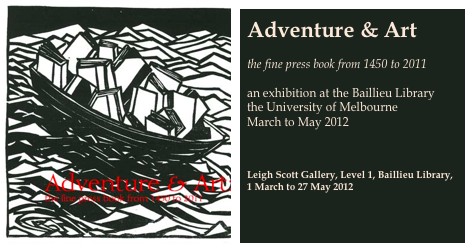Adventure and Art: The Fine Press Book from 1450 to 2011
Reviewed by John Weretka
 Adventure and Art: The Fine Press Book from 1450 to 2011 Curated by Alan Loney. Baillieu Library, University of Melbourne. Closes May 27th, 2012.
Adventure and Art: The Fine Press Book from 1450 to 2011 Curated by Alan Loney. Baillieu Library, University of Melbourne. Closes May 27th, 2012.
More exhibition information available on the Baillieu website.
So many of us live with so many books so much of the time that it is frequently difficult to take the book seriously as an object. Adventure and Art, curated by fine-press book maker Alan Loney, gathers around 50 examples of the fine-press book from the Gutenberg Bible to very recent examples of this art and, in so doing, makes a strong case not just for the persistence of this art form but for its often extraordinary beauty, in many cases transcending the information content of the words themselves.
On show in the Leigh Scott Gallery (Level 1 of the Baillieu Library at the University of Melbourne) until the end of May, the exhibition brings together material from the University’s own Special Collections as well as from private collections. A leaf from the Gutenberg Bible, recently acquired by the Library, shows the longevity of print types and mise-en-page. A small number of examples from the period between the mid-fifteenth century and the nineteenth century includes examples of hand-coloured plates in the medieval herbal tradition and in scientific material of the eighteenth century. The elegant brutality of Gering and Rembolt’s print of Gregory the Great’s Expositio (1498) points the way to some of the developments of the twentieth century, while showing a superb integration of printed symbol and text. The triumph of symbol over text is the focus of the 1847 Euclid printed by Pickering, in which coloured tesseræ litter a page containing a text we scarcely bother to read.
We leap rather suddenly into the Arts and Crafts movement’s rediscovery of the hand-made book, represented through superb examples including prints from the Kelmscott Press’s Chaucer of 1896, whole pages covered by Pugin-esque rinceaux. A series of books in this section of the exhibition brings into focus the links between image and text, with fine examples of the wood-engraver’s art on display, including some by Gwendolyn Raverat and Edward Burne-Jones. As a Doves Press English Bible of 1903 shows, the asperity of arranged type itself can provide the moving experience of the finest of wood engravings. The power of arranged type and mise-en-page form the theme of the Escutcheon Press’s 1999 How is a Man: commonplace book, a tour-de-force of graphic and type arrangement and the psychological impact they produce.
Australian fine-press books and the presses that produced them are a major focus of this exhibition, and it provides a thrilling opportunity to come to terms with the vitality of fine-press book production in this country and in New Zealand. Fine examples include Barn on the Hill’s First Fruits of Australian Poetry (1941) with its surging and yet cursive wood engraving of kangaroos; and Incunabula Press’s 1997 Pelican Poems, with John Ryrie’s woodcut of a ship full of books, a fitting synecdoche of the show. Very recent work is represented by Carolyn Fraser’s Seventeen Reasons (1999) and Loney’s own The Flowery Meadow (2005).
The intersection between the parallel arts of the book illustrator and the book printer/typesetter and so between text and image is a major focus of this show but the attentive viewer will also find arguments made subtly about the sensuousness of type, mise-en-page and even paper cut and manufacture in this exhibition.
© John Weretka 2012
